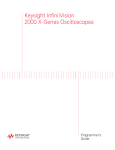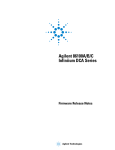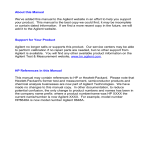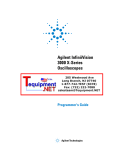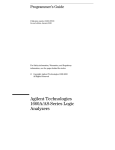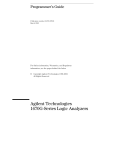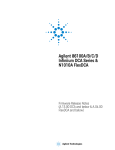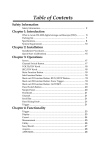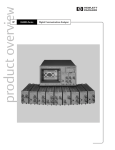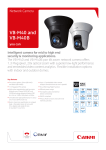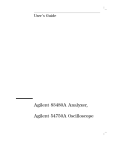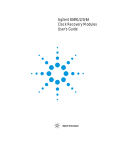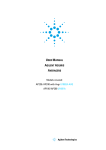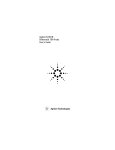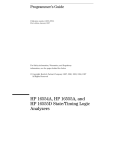Download Agilent Technologies Sprinkler 54753a User's Manual
Transcript
Agilent 54753A and 54754A
TDR Plug-in Modules
Programmer’s Quick Reference
Notices
Restricted Rights Legend
© Agilent Technologies, Inc. 2000-2004
If software is for use in the performance
of a U.S. Government prime contract or
subcontract, Software is delivered and
licensed as “Commercial computer software” as defined in DFAR 252.227-7014
(June 1995), or as a “commercial item” as
defined in FAR 2.101(a) or as “Restricted
computer software” as defined in FAR
52.227-19 (June 1987) or any equivalent
agency regulation or contract clause. Use,
duplication or disclosure of Software is
subject to Agilent Technologies’ standard
commercial license terms, and non-DOD
Departments and Agencies of the U.S.
Government will receive no greater than
Restricted Rights as defined in FAR
52.227-19(c)(1-2) (June 1987). U.S. Government users will receive no greater
than Limited Rights as defined in FAR
52.227-14 (June 1987) or DFAR 252.2277015 (b)(2) (November 1995), as applicable in any technical data.
No part of this manual may be reproduced in any form or by any means
(including electronic storage and
retrieval or translation into a foreign language) without prior agreement and written consent from Agilent Technologies,
Inc. as governed by United States and
international copyright lays.
Manual Part Number
54754-90013
Edition
July 2004
Printed in Malaysia
Agilent Technologies, Inc.
Digital Signal Analysis Division
1400 Fountaingrove Parkway
Santa Rosa, CA 95403, USA
Warranty
The material contained in this document
is provided “as is,” and is subject to being
changed, without notice, in future editions. Further, to the maximum extent
permitted by applicable law, Agilent disclaims all warranties, either express or
implied, with regard to this manual and
any information contained herein, including but not limited to the implied warranties of merchantability and fitness for a
particular purpose. Agilent shall not be
liable for errors or for incidental or consequential damages in connection with the
furnishing, use, or performance of this
document or of any information contained herein. Should Agilent and the
user have a separate written agreement
with warranty terms covering the material in this document that conflict with
these terms, the warranty terms in the
separate agreement shall control.
Technology Licenses
MS-DOS is a U.S. registered trademark
of Microsoft Corporation.
ii
Safety Notices
CAUTION
Caution denotes a hazard. It calls attention
to a procedure which, if not correctly performed or adhered to, could result in
damage to or destruction of the product.
Do not proceed beyond a caution sign
until the indicated conditions are fully
understood and met.
WARNING
Warning denotes a hazard. It calls attention
to a procedure which, if not correctly performed or adhered to, could result in
injury or loss of life. Do not proceed
beyond a warning sign until the indicated
conditions are fully understood and met.
Introduction
Introduction
54750A/83480A
Mainframes
For controlling 54753A and 54754A TDR plug-in modules that are installed in
a 54750A or 83480A mainframes, refer to the following books:
• This manual, the 54753A and 54754A TDR Plug-in Modules Programmer’s
Quick Reference
• 54753A and 54754A Programmer’s Guide for detailed information.
• 54750A Oscilloscope and 83480A Analyzer Programmer’s Guide for information about programming the oscilloscope.
• 54753A and 54754A User’s Guide for general information about the operation of the TDR plug-in module.
86100-Series
Mainframes
For controlling 54753A and 54754A TDR plug-in modules that are installed in
an 86100-series mainframe, refer to the following books:
• 86100-series programmer’s guide.
• 86100-series online help.
Notational
Conventions
computer type. All characters appearing in computer type are key
words and must be entered exactly as shown.
CAPITAL LETTERS. Capital letters indicate the short form of a command.
The actual command is not case sensitive and can be entered in upper or
lower case.
<>. Angular brackets enclose words or characters that symbolize a program
code parameter or an GPIB command.
::= "is defined as." For example, <A> ::= <B> indicates that <A> can be
replaced by <B> in any statement containing <A>.
| "or." Indicates a choice of one element from a list. For example, <A> | <B>
indicates <A> or <B> but not both.
... An ellipsis (trailing dots) indicate that the preceding element may be
repeated one or more times.
iii
Introduction
[ ] Square brackets indicate that the enclosed items are optional.
{ } When several items are enclosed by braces, one, and only one of these
elements may be selected.
Definitions
d ::= A single ASCII numeric character, 0-9.
n ::= A single ASCII non-zero, numeric character, 1-9.
<NL> ::= Newline or Linefeed (ASCII decimal 10).
<sp> ::= space character.
<white_space> ::= space(s) and tabs.
iv
Contents
Root Level Commands 4
Acquire Commands 7
Calibrate Commands 8
Channel Commands 9
Disk Commands 11
Display Commands 12
Function Commands 13
Histogram Commands 19
Limit Test Commands 20
Marker Commands 21
Mask Test Commands 23
Measure Commands 25
TDR Commands 37
Waveform Commands 41
Waveform Memory Commands 42
3
Root Level Commands
Command
:BLANk {CHANnel<number> | WMEMory<number> |
FUNCtion <number> | FFT | RESPonse<number> |
HISTogram | PMEMory1}
Turns off an active channel, function, waveform memory, pixel memory, FFT,
histogram, or TDR response. The VIEW command turns them on.
<number>
Command
For channels: an integer, 1 through 4, indicating the slot in which the channel
resides, followed by an optional A or B identifying which of two possible
channels in the slot is being referenced. For functions: 1 or 2. For waveform
memories (WMEMory): 1, 2, 3, or 4. For pixel memories (PMEMory): 1. For
TDR response: 1, 2, 3, or 4.
:COMMents {PLUGin<number>, <comments>}
Sets the comments field for the plugin. This field is used to describe options
included in the plugin, or for user commands about the plugin.
<number>
<comments>
Represents the plugin slot numbered 1 through 4.
Represents the unquoted string.
4
Root Level Commands
Command
:DIGitize [<waveform_name>][,<waveform_name>]
Invokes a special mode of data acquisition that is more efficient than using
the RUN command. This command initializes the selected channels,
functions, responses, or FFT to “unacquired,” then acquires them according
to the current instrument settings. When all signals are completely acquired,
the instrument is stopped.
<waveform_name>
<number>
Command
<number>
{CHANnel<number> | FUNCtion<number> | FFT |
RESPonse<number>}
For channels: an integer, 1 through 4, indicating the slot in which the channel
resides, followed by an optional A or B identifying which of two possible
channels in the slot is being referenced. For functions: 1 or 2. For responses:
1, 2, 3, or 4.
:MENU {APPLication | CHANnel<number> | ACQuire |
TIMebase | TRIGger | DISK | DISPlay | MARker |
MEASure | MATH | WAVeform | SETup | PRINt |
HELP | UTILity | FFT | LTESt | HISTogram |
MTESt | MEYE | TDR<number> | MTDR<number>}
For channels, indicates the slot (1 through 4) in which the channel resides,
followed by an optional A or B identifying which of two possible channels in
the slot is being referenced.
For TDR, controls the TDR/TDT menus for channels 2 and 4.
For MTDR, controls the TDR/TDT menus for channels 2 and 4.
5
Root Level Commands
Command
:STORe:WAVEform {CHANnel<number> |
FUNCtion<number> | WMEMory<number> | HISTogram |
FFT | RESPonse<number>},{WMEMory<number>}
Copies a channel, function, stored waveform, histogram, TDR response, or
FFT to a waveform memory. The first parameters specifies the source of the
copy and can be any channel, function, waveform memory, histogram, TDR
response, or the FFT. The second parameter is the destination of the copy,
and can be any waveform memory.
<number>
Command
For channels: an integer, 1 through 4, indicating the slot in which the channel
resides, followed by an optional A or B identifying which of two possible
channels in the slot is being referenced. For functions: 1 or 2. For waveform
memories (WMEMory): 1, 2, 3, or 4. For responses: 1, 2, 3, or 4.
:VIEW {CHANnel<number> | WMEMory<number> |
FUNCtion<number> | FFT | RESPonse<number> |
HISTogram | PMEMory1}
Turns on a channel, function, pixel memory, waveform memory, TDR
response, histogram, or FFT. Use the BLANk command to turn these off.
<number>
For channels: an integer, 1 through 4, indicating the slot in which the channel
resides, followed by an optional A or B identifying which of two possible
channels in the slot is being referenced. For functions: 1 or 2. For waveform
memories (WMEMory): 1, 2, 3, or 4. For TDR responses: 1, 2, 3, or 4. For
pixel memories (PMEMory): 1.
6
Acquire Commands
Command
:ACQuire:BEST[?] {THRuput | FLATness}
When averaging is enabled with ACQuire:AVERage, the FLATness option
improves the step flatness by using a signal processing algorithm within the
instrument. You should use this option when performing TDR measurements
or when step flatness is important. The THRuput option improves the
instrument’s throughput and should be used whenever best flatness is not
required.
7
Calibrate Commands
Command
:CALibrate:SAMPlers[?] {DISable | ENABle}
Enables or disables the samplers in the plug-in.
8
Channel Commands
Command
:CHANnel<number>:OFFSet[?] <offset_value>
For TDR and TDT applications, you may change the offset to magnify offset
in some circumstances. This command is used to set the magnify offset as
well as the offset.
<number>
An integer, 1-4, indicating the slot in which the channel resides.
<offset_value>
Offset value at center screen; can be volts, amperes, or other units.
Command
:CHANnel<number>:RANGe[?] <range_value>
For TDR and TDT applications, you may change the range to magnify range
in some circumstances. This command is used to set the magnify range as
well as the range.
<number>
<range_value>
Command
An integer, 1-4, indicating the slot in which the channel resides.
Full-scale voltage of the specified channel number.
:CHANnel<number>:SCALe[?] <scale_value>
For TDR and TDT applications, you may change the scale to magnify scale in
some circumstances. This command is used to set the magnify scale as well
as the scale.
<number>
<scale_value>
An integer, 1-4, indicating the slot in which the channel resides.
Vertical scale of the channel in units per division.
9
Channel Commands
Command
:CHANnel<number>:TDRSkew <percent> [%]
This command sets the TDR skew for the given channel. The TDR skew
control moves the TDR step relative to the trigger position. The control may
be set from -100 to 100 percent of the allowable range. This command is only
applicable to TDR channels.
<number>
<percent>
Command
An integer, 1 through 4, indicating the slot in which the channel resides,
followed by an optional A or B identifying which of two possible channels in
the slot is being referenced.
A number between -100 and 100, used to set the step position.
:CHANnel<number>:UNITs[?] {VOLT | AMPere | WATT |
UNKNown | OHM | REFLect | GAIN}
For TDR and TDT applications, you can select the units OHM, REFLect, and
GAIN. OHM and REFLect may be selected for TDR channels, while GAIN
may be selected for TDT channels. You must perform a normalization and a
reference plane calibration to select these units.
<number>
An integer, 1-4, indicating the slot in which the channel resides.
10
Disk Commands
Command
:DISK:LOAD "<filename>", <source>
Loads a setup, waveform, database, mask, TDR/TDT calibration, or pixel
memory from the disk. The filename does not include a suffix. The suffix
supplied by the instrument depends on the source and file format specified.
The TDRTDT option is a file type choice used to load TDR/TDT calibration
values into the instrument.
<source>
<filename>
<number>
Command
{DATabase | MASK | PMEMory 1 | SETup |
WMEMory<number> | TDRTDT}
Is an MS-DOS compatible file name up to 8 characters long.
Represents waveforms 1, 2, 3, or 4.
:DISK:STORe <source>, "<filename>"[,<format>]
Stores a setup, waveform, database, mask, TDR response, TDR/TDT
calibration, or pixel memory to the disk. The filename does not include a
suffix. The suffix is supplied by the instrument depending on the source and
file format specified. The database may only be saved in internal format.
<source>
<filename>
{DATabase | MASK | PMEMory 1 | SETup |
WMEMory<number> | TDRTDT}
Is an MS-DOS compatible file name up to 8 characters long.
<number>
Represents waveforms 1, 2, 3, or 4.
<format>
{TEXT [,YVALues | VERBose] | INTernal}
11
Display Commands
Command
:DISPlay:ASSign[?] {CHANnel<number> |
FUNCtion<number> | RESPonse<number> |
WMEMory<number> | FFT},{UPPer | LOWer}
Assigns the specified channel, waveform, function, TDR response, or FFT to
a particular portion of the waveform area on the screen. This command has
no effect when the graticule format is single.
<number>
For channels: an integer, 1 through 4, indicating the slot in which the channel
resides, followed by an optional A or B identifying which of two possible
channels in the slot is being referenced. For functions: 1 or 2. For waveform
memories (WMEMory): 1, 2, 3, or 4. For TDR responses: 1, 2, 3, or 4.
12
Function Commands
Command
:FUNCtion{1 | 2}:ADD <source>[,<source>]
Defines a function that takes the algebraic sum of two defined operands.
<source>
{CHANnel<number> | FUNCtion<number> |
RESPonse<number> | WMEMory<number> |
<float_value>}
<number>
For channels: an integer, 1 through 4, indicating the slot in which the channel
resides, followed by an optional A or B identifying which of two possible
channels in the slot is being referenced. For functions: 1. For waveform
memories (WMEMory): 1, 2, 3, or 4. For TDR responses: 1, 2, 3, or 4.
<float_value>
Command
A real number.
:FUNCtion{1 | 2}:BWLimit {{CHANnel<number> |
FUNCtion<number> | RESPonse<number> |
WMEMory<number>}, <bandwidth>}
Provides a bandwidth limit filter function. You can use this function on
waveforms to limit the bandwidth of the signal. In TDR or TDT applications
where the accuracy of normalization is not required, you can use this to
simulate a bandlimited signal through a device under test.
<number>
<bandwidth>
For channels: an integer, 1 through 4, indicating the slot in which the channel
resides, followed by an optional A or B identifying which of two possible
channels in the slot is being referenced. For functions: 1 or 2. For waveform
memories (WMEMory): 1, 2, 3, or 4. For TDR responses: 1, 2, 3, or 4.
Real number indicating frequency limit for the specified function.
13
Function Commands
Command
:FUNCtion{1 | 2}:DIFFerentiate {CHANnel<number> |
FUNCtion<number> | RESPonse<number> |
WMEMory<number> | <float_value>}
Computes the discrete derivative of the defined operand’s waveform.
<number>
<float_value>
Command
For channels: an integer, 1 through 4, indicating the slot in which the channel
resides, followed by an optional A or B identifying which of two possible
channels in the slot is being referenced. For functions: 1. For waveform
memories (WMEMory): 1, 2, 3, or 4. For TDR responses: 1, 2, 3, or 4.
A real number.
:FUNCtion{1 | 2}:DIVide <source>[,<source>]
Defines a function that divides the first operand by the second operand.
<source>
{CHANnel<number> | FUNCtion<number> |
RESPonse<number> | WMEMory<number> |
<float_value>}
<number>
For channels: an integer, 1 through 4, indicating the slot in which the channel
resides, followed by an optional A or B identifying which of two possible
channels in the slot is being referenced. For functions: 1. For waveform
memories (WMEMory): 1, 2, 3, or 4. For TDR responses: 1, 2, 3, or 4.
<float_value>
Command
A real number.
:FUNCtion{1 | 2}:FFTMagnitude {CHANnel<number> |
FUNCtion<number> | RESPonse<number> |
WMEMory<number> | <float_value>}
Defines a function that computes the FFT magnitude.
<number>
<float_value>
For channels: an integer, 1 through 4, indicating the slot in which the channel
resides, followed by an optional A or B identifying which of two possible
channels in the slot is being referenced. For functions: 1. For waveform
memories (WMEMory): 1, 2, 3, or 4. For TDR responses: 1, 2, 3, or 4.
A real number.
14
Function Commands
Command
:FUNCtion{1 | 2}:INTegrate {CHANnel<number> |
FUNCtion<number> | RESPonse<number> |
WMEMory<number> | <float_value>}
Defines a function that computes the integral of the defined operand’s
waveform.
<number>
<float_value>
Command
For channels: an integer, 1 through 4, indicating the slot in which the channel
resides, followed by an optional A or B identifying which of two possible
channels in the slot is being referenced. For functions: 1. For waveform
memories (WMEMory): 1, 2, 3, or 4. For TDR responses: 1, 2, 3, or 4.
A real number.
:FUNCtion{1 | 2}:INVert {CHANnel<number> |
FUNCtion<number> | RESPonse<number> |
WMEMory<number> | <float_value>}
Defines a function that inverts the defined operand’s waveform by
multiplying by -1.
<number>
<float_value>
Command
For channels: an integer, 1 through 4, indicating the slot in which the channel
resides, followed by an optional A or B identifying which of two possible
channels in the slot is being referenced. For functions: 1. For waveform
memories (WMEMory): 1, 2, 3, or 4. For TDR responses: 1, 2, 3, or 4.
A real number.
:FUNCtion{1 | 2}:MAGNify {CHANnel<number> |
FUNCtion<number> | RESPonse<number> |
WMEMory<number> | <float_value>}
Defines a function that is a copy of the operand. The magnify function is a
software magnify. No hardware settings are altered as a result of using this
function. It is useful for scaling channels, another function, TDR/TDT
responses and memories with the RANGE and OFFSET commands in this
subsystem.
Magnify performs the same operation as the "ONLY" operator, and is the
preferred operator of the two. "ONLY" is included in this instrument for
compatibility with previous instruments.
15
Function Commands
<number>
<float_value>
Command
For channels: an integer, 1 through 4, indicating the slot in which the channel
resides, followed by an optional A or B identifying which of two possible
channels in the slot is being referenced. For functions: 1. For waveform
memories (WMEMory): 1, 2, 3, or 4. For TDR responses: 1, 2, 3, or 4.
A real number.
:FUNCtion{1 | 2}:MAXimum {CHANnel<number> |
FUNCtion<number> | RESPonse<number> |
WMEMory<number> | <float_value>}
Defines a function that computes the maximum value of the operand
waveform in each time bucket.
<number>
<float_value>
Command
For channels: an integer, 1 through 4, indicating the slot in which the channel
resides, followed by an optional A or B identifying which of two possible
channels in the slot is being referenced. For functions: 1. For waveform
memories (WMEMory): 1, 2, 3, or 4. For TDR responses: 1, 2, 3, or 4.
A real number.
:FUNCtion{1 | 2}:MINimum {CHANnel<number> |
FUNCtion<number> | RESPonse<number> |
WMEMory<number> | <float_value>}
Defines a function that computes the minimum of each time bucket for the
defined operand’s waveform.
<number>
<float_value>
For channels: an integer, 1 through 4, indicating the slot in which the channel
resides, followed by an optional A or B identifying which of two possible
channels in the slot is being referenced. For functions: 1. For waveform
memories (WMEMory): 1, 2, 3, or 4. For TDR responses: 1, 2, 3, or 4.
A real number.
16
Function Commands
Command
:FUNCtion{1 | 2}:MULTiply <source>[,<source>]
Defines a function that algebraically multiplies the first operand by the
second operand.
<source>
{CHANnel<number> | FUNCtion<number> |
RESPonse<number> | WMEMory<number> |
<float_value>}
<number>
For channels: an integer, 1 through 4, indicating the slot in which the channel
resides, followed by an optional A or B identifying which of two possible
channels in the slot is being referenced. For functions: 1. For waveform
memories (WMEMory): 1, 2, 3, or 4. For TDR responses: 1, 2, 3, or 4.
<float_value>
Command
A real number.
:FUNCtion{1 | 2}:SUBTract <source>[,<source>]
Defines a function that algebraically subtracts the second operand from the
first operand.
<source>
{CHANnel<number> | FUNCtion<number> |
RESPonse<number> | WMEMory<number> |
<float_value>}
<number>
For channels: an integer, 1 through 4, indicating the slot in which the channel
resides, followed by an optional A or B identifying which of two possible
channels in the slot is being referenced. For functions: 1. For waveform
memories (WMEMory): 1, 2, 3, or 4. For TDR responses: 1, 2, 3, or 4.
<float_value>
A real number.
17
Function Commands
Command
:FUNCtion{1 | 2}:VERSus <source>[,<source>]
Defines a function for an X-versus-Y display. The first operand defines the
Y axis and the second defines the X axis. The Y-axis range and offset are
initially equal to that of the first operand and can be adjusted with the
RANGE and OFFSET commands.
<source>
{CHANnel<number> | FUNCtion<number> |
RESPonse<number> | WMEMory<number> |
<float_value>}
<number>
For channels: an integer, 1 through 4, indicating the slot in which the channel
resides, followed by an optional A or B identifying which of two possible
channels in the slot is being referenced. For functions: 1. For waveform
memories (WMEMory): 1, 2, 3, or 4. For TDR responses: 1, 2, 3, or 4.
<float_value>
A real number.
18
Histogram Commands
Command
:HISTogram:WINDow:SOURce[?] {CHANnel<number> |
FUNCtion<number> | RESPonse<number> |
WMEMory<number> | FFT}
Selects the source of the histogram window. The histogram window will track
the source’s vertical and horizontal scale.
<number>
For channels: an integer, 1 through 4, indicating the slot in which the channel
resides, followed by an optional A or B identifying which of two possible
channels in the slot is being referenced. For functions: 1 or 2. For waveform
memories (WMEMory): 1, 2, 3, or 4. For TDR response: 1, 2, 3, or 4.
19
Limit Test Commands
Command
:LTESt:SWAVeform[?]
<source>,<destination>,[,<filename>[,<format>]]
Saves waveforms from a channel, function, histogram, TDR response, or
waveform memory in the event of a failure detected by the limit test. Each
waveform source can be individually specified, allowing multiple channels or
functions to be saved to disk or waveform memories. Setting a particular
source to OFF removes any waveform save action from that source.
<source>
<destination>
{CHANnel<number> | FUNCtion<number> | HISTogram
| RESPonse<number> | WMEMory<number>}
{OFF | WMEMory<number> | DISK}
When DISK is selected, a file name is required.
<filename>
<format>
A descriptive file prefix consisting of up to four characters. If no filename is
specified, the prefix defaults to CH1A..CH4B, FN1, FN2, FFT, HIST,
MEM1..MEM4, RSP1..RSP4.
{TEXT [,YVALues | VERBose] | INTernal}
20
Marker Commands
Command
:MARKer:MODE[?] {OFF | MANual | WAVeform |
MEASurement | HISTogram | TDRTDT}
Sets the marker mode.
Command
:MARKer:PROPagation[?] {DIELectric | METer | FEET}
<propagation>
Sets the propagation velocity for TDR and TDT measurements. The
propagation may be specified as a dielectric constant or in meters per second
or feet per second. The value is used to determine the distance from the
reference plane in TDR and TDT marker measurements.
<propagation>
Command
Dielectric constant or propagation value.
:MARKer:REFerence[?] {TRIGger | REFerence}
Specifies the marker reference for TDR and TDT style markers. If the
reference is TRIGger, then all horizontal axis marker measurements are made
with respect to the trigger point. If the reference is REFerence, then all
horizontal axis marker measurements are made with respect to the reference
plane. You must perform a normalization and reference plane calibration
before using a reference plane reference. This feature is available only for
TDR and TDT applications.
21
Marker Commands
Command
:MARKer:X1Y1source[?] {CHANnel<number> |
FUNCtion<number> | RESPonse<number> |
WMEMory<number> | HISTogram | FFT}
Sets the source for the X1 and Y1 markers.
<number>
Command
For channels: an integer, 1 through 4, indicating the slot in which the channel
resides, followed by an optional A or B indicating which of two possible
channels in the slot is being referenced. For functions: 1 or 2. For waveform
memories (WMEMory): 1, 2, 3, or 4. For TDR response: 1, 2, 3, or 4.
:MARKer:X2Y2source[?] {CHANnel<number> |
FUNCtion<number> | RESPonse<number> |
WMEMory<number> | HISTogram | FFT}
Sets the source for the X2 and Y2 markers.
<number>
Command
For channels: an integer, 1 through 4, indicating the slot in which the channel
resides, followed by an optional A or B indicating which of two possible
channels in the slot is being referenced. For functions: 1 or 2. For waveform
memories (WMEMory): 1, 2, 3, or 4. For TDR response: 1, 2, 3, or 4.
:MARKer:XUNITs[?] {SECond | METer | FEET}
Sets the units for horizontal display in TDR and TDT applications. The units
may be in seconds, meters, or feet relative to the trigger or reference plane.
The marker mode must be TDRTDT to use this feature. See the
:MARKer:REFerence command for information on setting the reference point.
Command
:MARKer:YUNITs[?] {VOLT | OHM | REFlect}
Sets the units for vertical display in TDR and TDT applications. The units
may be in volts, ohms, or % relection. The marker mode must be TDRTDT to
use this features.
22
Mask Test Commands
Command
:MTESt:AMASk:SOURce[?] {CHANnel<number> |
FUNCtion<number> | RESPonse<number> |
WMEMory<number> | FFT}
Selects the source for the interpretation of the AMASk:XDELta and
AMASk:YDELta parameters when AMASk:UNITs is set to CURRent. When
UNITs are CURRent, the XDELta and YDELta parameters are defined in
terms of the measurement system of the selected source.
<number>
Command
For channels: an integer, 1 through 4, indicating the slot in which the channel
resides, followed by an optional A or B indicating which of two possible
channels in the slot is being referenced. For functions: 1 or 2. For waveform
memories (WMEMory): 1, 2, 3, or 4. For TDR response: 1, 2, 3, or 4.
:MTESt:SWAVeform[?]
<source>,<destination>[,<filename>[,<format>]]
Saves waveforms from a channel, function, TDR response, histogram, or
waveform memory in the event of a failure detected by the Mask Test. Each
waveform source can be individually specified, allowing multiple channels or
functions to be saved to disk or waveform memories. Setting a particular
source to OFF removes any waveform save action from that source.
<source>
{CHANnel<number> | FUNCtion<number> |
RESPonse<number> | WMEMory<number> | HISTogram |
FFT}
23
Mask Test Commands
<number>
<destination>
<filename>
<format>
Command
For channels: an integer, 1 through 4, indicating the slot in which the channel
resides, followed by an optional A or B identifying which of two possible
channels in the slot is being referenced. For functions: 1 or 2. For waveform
memories (WMEMory): 1, 2, 3, or 4. For TDR responses: 1, 2, 3, or 4.
{OFF | WMEMory<number> | DISK}
A descriptive file prefix consisting of up to four characters. If no filename is
specified, the prefix defaults to CH1A..CH4B, FN1, FN2, FFT, HIST,
MEM1..MEM4, RSP1..RSP4.
{TEXT [,YVALues | VERBose ] | INTernal}
:MTESt:SCALe:SOURce[?] {CHANnel<number> |
FUNCtion<number> | RESPonse<number> |
WMEMory<number>}
Sets the source used by the mask subsystem for interpretation of the
SCALe:Y1 and SCALe:Y2 parameters. SCALe:Y1 and SCALe:Y2 set the
vertical boundaries of the coordinate system for mask testing, and are
affected by the scaling of the selected source.
<number>
For channels: an integer, 1 through 4, indicating the slot in which the channel
resides, followed by an optional A or B indicating which of two possible
channels in the slot is being referenced. For functions: 1 or 2. For waveform
memories (WMEMory): 1, 2, 3, or 4. For TDR response: 1, 2, 3, or 4.
24
Measure Commands
Command
:MEASure:DELTatime[?] [<source>[,<source>]]
Measures the delta time between two edges. If one source is specified, the
delta time from the leading edge of the specified source ot the trailing edge of
the specified source is measured. If two sources are specified, the delta time
from the leading edge on the first source to the trailing edge on the second
source is measured.
<source>
{CHANnel<number> | FUNCtion<number> |
RESPonse<number> | WMEMory<number>}
<number>
For channels: an integer, 1 through 4, indicating the slot in which the channel
resides, followed by an optional A or B identifying which of two possible
channels in the slot is being referenced. For functions: 1 or 2. For waveform
memories (WMEMory): 1, 2, 3, or 4. For TDR responses: 1, 2, 3, or 4.
Command
:MEASure:DUTycycle[?] [<source>]
Measures the ratio of the positive pulse width to the period.
<source>
{CHANnel<number> | FUNCtion<number> |
RESPonse<number> | WMEMory<number>}
<number>
For channels: an integer, 1 through 4, indicating the slot in which the channel
resides, followed by an optional A or B identifying which of two possible
channels in the slot is being referenced. For functions: 1 or 2. For waveform
memories (WMEMory): 1, 2, 3, or 4. For TDR responses: 1, 2, 3, or 4.
25
Measure Commands
Command
:MEASure:FALLtime[?] [<source>]
Measures the time at the upper threshold of the falling edge, measures the
time at the lower threshold of the falling edge, then calculates the fall time.
<source>
{CHANnel<number> | FUNCtion<number> |
RESPonse<number> | WMEMory<number>}
<number>
For channels: an integer, 1 through 4, indicating the slot in which the channel
resides, followed by an optional A or B identifying which of two possible
channels in the slot is being referenced. For functions: 1 or 2. For waveform
memories (WMEMory): 1, 2, 3, or 4. For TDR responses: 1, 2, 3, or 4.
Command
:MEASure:FREQuency[?] [<source>]
Measures the frequency of the first complete cycle on the screen using the
mid-threshold levels of the waveform (50% levels if standard measurements
are selected).
<source>
{CHANnel<number> | FUNCtion<number> |
RESPonse<number> | WMEMory<number>}
<number>
For channels: an integer, 1 through 4, indicating the slot in which the channel
resides, followed by an optional A or B identifying which of two possible
channels in the slot is being referenced. For functions: 1 or 2. For waveform
memories (WMEMory): 1, 2, 3, or 4. For TDR responses: 1, 2, 3, or 4.
26
Measure Commands
Command
:MEASure:NWIDTh[?] [<source>]
Measures the width of the first negative pulse on the screen using the
mid-threshold levels of the waveform (50% levels with standard
measurements selected).
<source>
{CHANnel<number> | FUNCtion<number> |
RESPonse<number> | WMEMory<number>}
<number>
For channels: an integer, 1 through 4, indicating the slot in which the channel
resides, followed by an optional A or B identifying which of two possible
channels in the slot is being referenced. For functions: 1 or 2. For waveform
memories (WMEMory): 1, 2, 3, or 4. For TDR responses: 1, 2, 3, or 4.
Command
:MEASure:OVERshoot[?] [<source>]
Measures the width of the overshoot of the first edge on the screen.
<source>
{CHANnel<number> | FUNCtion<number> |
RESPonse<number> | WMEMory<number>}
<number>
For channels: an integer, 1 through 4, indicating the slot in which the channel
resides, followed by an optional A or B identifying which of two possible
channels in the slot is being referenced. For functions: 1 or 2. For waveform
memories (WMEMory): 1, 2, 3, or 4. For TDR responses: 1, 2, 3, or 4.
Command
:MEASure:PERiod[?] [<source>]
Measures the period of the first complete cycle on the screen using the
mid-threshold levels of the waveform (50% levels with standard
measurements selected).
<source>
{CHANnel<number> | FUNCtion<number> |
RESPonse<number> | WMEMory<number>}
27
Measure Commands
<number>
Command
For channels: an integer, 1 through 4, indicating the slot in which the channel
resides, followed by an optional A or B identifying which of two possible
channels in the slot is being referenced. For functions: 1 or 2. For waveform
memories (WMEMory): 1, 2, 3, or 4. For TDR responses: 1, 2, 3, or 4.
:MEASure:PREShoot[?] [<source>]
Measures the preshoot of the first edge on the screen.
<source>
{CHANnel<number> | FUNCtion<number> |
RESPonse<number> | WMEMory<number>}
<number>
For channels: an integer, 1 through 4, indicating the slot in which the channel
resides, followed by an optional A or B identifying which of two possible
channels in the slot is being referenced. For functions: 1 or 2. For waveform
memories (WMEMory): 1, 2, 3, or 4. For TDR responses: 1, 2, 3, or 4.
Command
:MEASure:PWIDth[?] [<source>]
Measures the width of the first positive pusle on the screen using the
mid-threshold levels of the waveform (50% levels with standard
measurements selected).
<source>
{CHANnel<number> | FUNCtion<number> |
RESPonse<number> | WMEMory<number>}
<number>
For channels: an integer, 1 through 4, indicating the slot in which the channel
resides, followed by an optional A or B identifying which of two possible
channels in the slot is being referenced. For functions: 1 or 2. For waveform
memories (WMEMory): 1, 2, 3, or 4. For TDR responses: 1, 2, 3, or 4.
28
Measure Commands
Command
:MEASure:RISetime[?] [<source>]
Measures the rise time of the first displayed edge by measuring the time at
the lower threshold of the rising edge, measuring the time at the upper
threshold of the rising edge, then calculating the rise time.
<source>
{CHANnel<number> | FUNCtion<number> |
RESPonse<number> | WMEMory<number>}
<number>
For channels: an integer, 1 through 4, indicating the slot in which the channel
resides, followed by an optional A or B identifying which of two possible
channels in the slot is being referenced. For functions: 1 or 2. For waveform
memories (WMEMory): 1, 2, 3, or 4. For TDR responses: 1, 2, 3, or 4.
Command
:MEASure:SOURce[?] <source>[,<source>]
Selects the source for measurements. Two sources can be specified with this
command. All measurements except MEASure:DELTatime are made on the
first specified source. The delta time measurement uses two sources if two
are specified. If only one source is specified, the delta time measurement
uses that source for both of its parameters.
<source>
{CHANnel<number> | FUNCtion<number> |
RESPonse<number> | WMEMory<number> | HISTogram |
FFT}
<number>
For channels: an integer, 1 through 4, indicating the slot in which the channel
resides, followed by an optional A or B identifying which of two possible
channels in the slot is being referenced. For functions: 1 or 2. For waveform
memories (WMEMory): 1, 2, 3, or 4. For TDR responses: 1, 2, 3, or 4.
29
Measure Commands
Command
:MEASURE:TEDge[?] <meas_thres_txt>,
<slope><occurrence>[,<source>]
Measures the time interval between the trigger event and the specified
threshold level and transition.
<meas_thres_
txt>
<slope>
<occurrence>
{UPPer | MIDDle | LOWer}
{- (minus) for falling | + (plus) (optional) for rising}
Numeric value representing which edge of the occurrence should be used for
the measurement.
<source>
{CHANnel<number> | FUNCtion<number> |
RESPonse<number> | WMEMory<number>}
<number>
For channels: an integer, 1 through 4, indicating the slot in which the channel
resides, followed by an optional A or B identifying which of two possible
channels in the slot is being referenced. For functions: 1 or 2. For waveform
memories (WMEMory): 1, 2, 3, or 4. For TDR responses: 1, 2, 3, or 4.
Command
:MEASure:TMAX[?] [<source>]
Measures the first time at which the maximum voltage of the source
waveform occurred. When FFT is the specified source, the frequency at
which the first maximum value occurred is measured.
<source>
{CHANnel<number> | FUNCtion<number> |
RESPonse<number> | WMEMory<number> | FFT}
<number>
For channels: an integer, 1 through 4, indicating the slot in which the channel
resides, followed by an optional A or B identifying which of two possible
channels in the slot is being referenced. For functions: 1 or 2. For waveform
memories (WMEMory): 1, 2, 3, or 4. For TDR responses: 1, 2, 3, or 4.
30
Measure Commands
Command
:MEASure:TMIN[?] [<source>]
Measures the time at which the first minimum voltage of the source
waveform occurred. When FFT is the specified source, the frequency at
which the first minimum value occurred is measured.
<source>
{CHANnel<number> | FUNCtion<number> |
RESPonse<number> | WMEMory<number> | FFT}
<number>
For channels: an integer, 1 through 4, indicating the slot in which the channel
resides, followed by an optional A or B identifying which of two possible
channels in the slot is being referenced. For functions: 1 or 2. For waveform
memories (WMEMory): 1, 2, 3, or 4. For TDR responses: 1, 2, 3, or 4.
Command
:MEASure:TVOLt[?] <voltage>,
<slope><occurrence>[,<source>]
Measures the time interval between the trigger event and the defined voltage
level and transition.
<voltage>
<slope>
<occurrence>
Voltage level at which time will be measured.
The direction of the waveform change when the specified voltage is crossed,
either rising (+) or falling (-).
The number of the crossing to be reported (if one, the first crossing is
reported; if two, the second is reported, and so on).
<source>
{CHANnel<number> | FUNCtion<number> |
RESPonse<number> | WMEMory<number>}
<number>
For channels: an integer, 1 through 4, indicating the slot in which the channel
resides, followed by an optional A or B identifying which of two possible
channels in the slot is being referenced. For functions: 1 or 2. For waveform
memories (WMEMory): 1, 2, 3, or 4. For TDR responses: 1, 2, 3, or 4.
31
Measure Commands
Command
:MEASure:VAMPlitude[?] [<source>]
Calculates the difference between the top and base voltage of the specified
source.
<source>
{CHANnel<number> | FUNCtion<number> |
RESPonse<number> | WMEMory<number>}
<number>
For channels: an integer, 1 through 4, indicating the slot in which the channel
resides, followed by an optional A or B identifying which of two possible
channels in the slot is being referenced. For functions: 1 or 2. For waveform
memories (WMEMory): 1, 2, 3, or 4. For TDR responses: 1, 2, 3, or 4.
Command
:MEASure:VAVerage[?] {CYCLe | DISPlay},[<source>]
Calculates the average voltage over the displayed waveform.
<source>
{CHANnel<number> | FUNCtion<number> |
RESPonse<number> | WMEMory<number>}
<number>
For channels: an integer, 1 through 4, indicating the slot in which the channel
resides, followed by an optional A or B identifying which of two possible
channels in the slot is being referenced. For functions: 1 or 2. For waveform
memories (WMEMory): 1, 2, 3, or 4. For TDR responses: 1, 2, 3, or 4.
Command
:MEASure:VBASe[?] [<source>]
Measures the statistical base of the waveform.
<source>
{CHANnel<number> | FUNCtion<number> |
RESPonse<number> | WMEMory<number>}
<number>
For channels: an integer, 1 through 4, indicating the slot in which the channel
resides, followed by an optional A or B identifying which of two possible
channels in the slot is being referenced. For functions: 1 or 2. For waveform
memories (WMEMory): 1, 2, 3, or 4. For TDR responses: 1, 2, 3, or 4.
32
Measure Commands
Command
:MEASure:VLOWer[?] [<source>]
Measures the voltage value at the lower threshold of the waveform.
<source>
{CHANnel<number> | FUNCtion<number> |
RESPonse<number> | WMEMory<number>}
<number>
For channels: an integer, 1 through 4, indicating the slot in which the channel
resides, followed by an optional A or B identifying which of two possible
channels in the slot is being referenced. For functions: 1 or 2. For waveform
memories (WMEMory): 1, 2, 3, or 4. For TDR responses: 1, 2, 3, or 4.
Command
:MEASure:VMAX[?] [<source>]
Measures the absolute maximum voltage present on the selected source
waveform. When FFT is the specified source, the maximum value in
spectrum is measured.
<source>
{CHANnel<number> | FUNCtion<number> |
RESPonse<number> | WMEMory<number> | FFT}
<number>
For channels: an integer, 1 through 4, indicating the slot in which the channel
resides, followed by an optional A or B identifying which of two possible
channels in the slot is being referenced. For functions: 1 or 2. For waveform
memories (WMEMory): 1, 2, 3, or 4. For TDR responses: 1, 2, 3, or 4.
Command
:MEASure:VMIDdle[?] [<source>]
Measures the voltage value at the middle threshold of the waveform.
<source>
{CHANnel<number> | FUNCtion<number> |
RESPonse<number> | WMEMory<number>}
<number>
For channels: an integer, 1 through 4, indicating the slot in which the channel
resides, followed by an optional A or B identifying which of two possible
channels in the slot is being referenced. For functions: 1 or 2. For waveform
memories (WMEMory): 1, 2, 3, or 4. For TDR responses: 1, 2, 3, or 4.
33
Measure Commands
Command
:MEASure:VMIN[?] [<source>]
Measures the absolute minimum voltage present on the selected source
waveform. When FFT is the specified source, the minimum value in the
spectrum is measured.
<source>
{CHANnel<number> | FUNCtion<number> |
RESPonse<number> | WMEMory<number> | FFT}
<number>
For channels: an integer, 1 through 4, indicating the slot in which the channel
resides, followed by an optional A or B identifying which of two possible
channels in the slot is being referenced. For functions: 1 or 2. For waveform
memories (WMEMory): 1, 2, 3, or 4. For TDR responses: 1, 2, 3, or 4.
Command
:MEASure:VPP[?] [<source>]
Measures the absolute maximum and minimum voltages on the selected
source, then calculates the peak-to-peak voltage as the difference between
the two voltages. When FFT is the specified source, the range of values in the
spectrum is measured.
<source>
{CHANnel<number> | FUNCtion<number> |
RESPonse<number> | WMEMory<number> | FFT}
<number>
For channels: an integer, 1 through 4, indicating the slot in which the channel
resides, followed by an optional A or B identifying which of two possible
channels in the slot is being referenced. For functions: 1 or 2. For waveform
memories (WMEMory): 1, 2, 3, or 4. For TDR responses: 1, 2, 3, or 4.
34
Measure Commands
Command
:MEASure:VRMS[?] {CYCLe | DISPlay}, {AC | DC}
[,<source>]
Measures the RMS voltage of the selected waveform by subtracting the
average value of the waveform from each data point on the display.
<source>
{CHANnel<number> | FUNCtion<number> |
RESPonse<number> | WMEMory<number>}
<number>
For channels: an integer, 1 through 4, indicating the slot in which the channel
resides, followed by an optional A or B identifying which of two possible
channels in the slot is being referenced. For functions: 1 or 2. For waveform
memories (WMEMory): 1, 2, 3, or 4. For TDR responses: 1, 2, 3, or 4.
Command
:MEASure:VTIMe[?] <time>[,<source>]
Measures the voltage at the specified time. The time is referenced to the
trigger event and must be on the screen. When FFT is the specified source,
the value at the specified frequency is measured.
<time>
Displayed time from the trigger in seconds, or frequency in Hertz for FFT.
<source>
{CHANnel<number> | FUNCtion<number> |
RESPonse<number> | WMEMory<number> | FFT}
<number>
For channels: an integer, 1 through 4, indicating the slot in which the channel
resides, followed by an optional A or B identifying which of two possible
channels in the slot is being referenced. For functions: 1 or 2. For waveform
memories (WMEMory): 1, 2, 3, or 4. For TDR responses: 1, 2, 3, or 4.
35
Measure Commands
Command
:MEASure:VTOP[?] [<source>]
Measures the statistical top of the selected source waveform.
<source>
{CHANnel<number> | FUNCtion<number> |
RESPonse<number> | WMEMory<number>}
<number>
For channels: an integer, 1 through 4, indicating the slot in which the channel
resides, followed by an optional A or B identifying which of two possible
channels in the slot is being referenced. For functions: 1 or 2. For waveform
memories (WMEMory): 1, 2, 3, or 4. For TDR responses: 1, 2, 3, or 4.
Command
:MEASure:VUPper[?] [<source>]
Measures the voltage value at the upper threshold of the waveform.]
<source>
{CHANnel<number> | FUNCtion<number> |
RESPonse<number> | WMEMory<number>}
<number>
For channels: an integer, 1 through 4, indicating the slot in which the channel
resides, followed by an optional A or B identifying which of two possible
channels in the slot is being referenced. For functions: 1 or 2. For waveform
memories (WMEMory): 1, 2, 3, or 4. For TDR responses: 1, 2, 3, or 4.
36
TDR Commands
Command
:TDR{2 | 4}:RESPonse{1 | 2 | 3 | 4}:CALibrate
Begins a TDR or TDT normalization and reference plane calibration. Which
calibration is done (TDR or TDT) depends on the setting of the TDRTDT
control.
Command
:TDR{2 | 4}:RESPonse{1 | 2 | 3 | 4}:CALibrate
:CANCel
Activates the cancel softkey during a TDR or TDT normalization and
reference plane calibration.
Command
:TDR{2 | 4}:RESPonse{1 | 2 | 3 | 4}:CALibrate
:CONTinue
Activates the continue softkey during a TDR or TDT normalization and
reference plane calibration.
Command
:TDR{2 | 4}:PRESet
Sets up the instrument for TDR or TDT measurements, based on the
stimulus.
37
TDR Commands
Command
:TDR{2 | 4}:RATE[?] {AUTO | <rate>}
Sets the period of the TDR pulse generator. You should usually leave this set
to AUTO unless you need to define a specific rate. In AUTO, the instrument
will attempt to keep subsequent periods off screen when the timebase is
changed.
<rate>
Command
Period to which you want to set the generator, in Hertz. You can add a suffix
to indicate that the rate is in Hertz (HZ, KHZ, MHZ, and so on).
:TDR{2 | 4}:RESPonse{1 | 2 | 3 | 4}[?] {OFF |
DIFFerential | COMMonmode | NORMalize}
Turns on or off the response of a TDR or TDT stimulus.
Command
:TDR{2 | 4}:RESPonse{1 | 2 | 3 | 4}:HORizontal[?]
{TSOurce, MANual}
Specifies whether the TDR/TDT response should track the source channel’s
horizontal scale (TSOurce), or use a user-defined scale specified with the
HORizontal:POSItion and HORizontal:RANGe commands (MANual). TSOurce
is the usual setting.
Command
:TDR{2 | 4}:RESPonse{1 | 2 | 3 | 4):
HORizontal:POSition[?] <position>
Specifies the horizontal position of the TDR/TDT response when horizontal
tracking is set to manual. The position is always referenced to center screen.
<position>
Command
Offset from the center of the screen, in seconds.
:TDR{2 | 4}:RESPonse{1 | 2 | 3 | 4}:
HORizontal:RANGe[?] <range>
Specifies the range of the TDR/TDT response when the horizontal tracking is
set to manual.
<range>
Horizontal range in seconds.
38
TDR Commands
Command
:TDR{2 | 4}:RESPonse{1 | 2 | 3 | 4}:RISetime[?]
<risetime>
Sets the risetime for the normalized response. The risetime setting is limited
by the timebase settings and the record length.
<risetime>
Command
Risetime setting in seconds.
:TDR{2 | 4}:RESPonse{1 | 2 | 3 | 4}:TDRDest[?]
CHANnel<number>
Selects a TDR destination channel for an external stimulus. When you use an
external stimulus, you must use this command to specify where the TDR
channel is coming into the instrument.
<number>
Command
An integer, 1 through 4, indicating the slot in which the channel resides,
followed by an optional A or B identifying which of two possible channels in
the slot is being referenced.
:TDR{2 | 4}:RESPonse{1 | 2 | 3 | 4}:TDRTDT[?]
{TDR | TDT}
Sets the instrument to make either TDR or TDT measurements. When the
setting is TDT, both TDR and TDT measurements can be made
simultaneously. You must select a TDT destination channel before selecting
TDT.
Command
:TDR{2 | 4}:RESPonse{1 | 2 | 3 | 4}:TDTDest[?]
{NONE | CHANnel<number>}
Selects a destination channel for a normalization measurement.
<number>
An integer, 1 through 4, indicating the slot in which the channel resides,
followed by an optional A or B identifying which of two possible channels in
the slot is being referenced.
39
TDR Commands
Command
:TDR{2 | 4}:RESPonse{1 | 2 | 3 | 4}:VERTical[?]
{TSOurce | MANual}
Specifies whether the TDR/TDT response should track the source channel’s
vertical scale (TSOurce), or use a user-defined scale specified with the
VERTical:OFFSet and VERTical:RANGe commands (MANual). TSOurce is
the usual setting.
Command
:TDR{2 | 4}:RESPonse{1 | 2 | 3 | 4}:
VERTical:OFFSet[?] <offset_value>
Sets the vertical position of the specified response when vertical tracking is
set to MANual. The position is always referenced to center screen.
<offset_value>
Offset value in volts, watts, or decibels, depending on the current channel
UNITs. Suffix UNITs are ignored; only the scalar part is used (“m” in “mw”).
Command
:TDR{2 | 4}:RESPonse{1 | 2 | 3 | 4}:
VERTical:RANGe[?] <range_value>
Specifies the vertical range of the TDR/TDT response when the vertical
tracking mode is set to MANual.
<range_value>
Command
Vertical range in volts, watts, or decibels, depending on the current UNITs
setting and suffix supplied. (The suffix does not set the UNITs; it is ignored.)
:TDR{2 | 4}:STIMulus[?] {OFF | ON | ON1 | ON2 |
ON1AND2 | DIFFerential | COMMonmode |EXTernal |
ON3 | ON4 | ON3AND4}
Turns the TDR/TDT stimulus on or off.
40
Waveform Commands
Command
:WAVeform:SOURce[?] {CHANnel<number> |
FUNCtion<number> | RESPonse<number> |
WMEMory<number> | DATabase | HISTogram | FFT}
Selects a channel, function, TDR response, waveform memory, database,
histogram, or FFT as the waveform source.
<number>
For channels: an integer, 1 through 4, indicating the slot in which the channel
resides, followed by an optional A or B identifying which of two possible
channels in the slot is being referenced. For functions: 1 or 2. For waveform
memories (WMEMory): 1, 2, 3, or 4. For TDR responses: 1, 2, 3, or 4.
41
Waveform Memory Commands
Command
:WMEMory<number>:SAVE {CHANnel<number> |
FUNCtion<number> | RESPonse<number> |
WMEMory<number> | HISTogram | FFT}
Stores the specific channel, waveform memory, function, histogram, or FFT
to the waveform memory.
<number>
For channels: an integer, 1 through 4, indicating the slot in which the channel
resides, followed by an optional A or B identifying which of two possible
channels in the slot is being referenced. For functions: 1 or 2. For waveform
memories (WMEMory): 1, 2, 3, or 4. Storing a waveform memory to itself
does not change the memory. For TDR responses: 1, 2, 3, or 4.
42












































